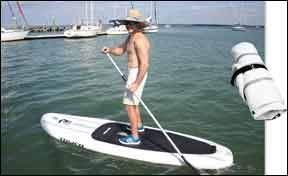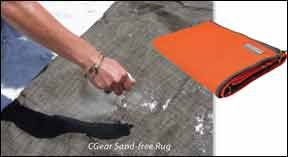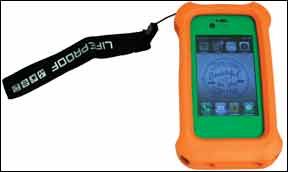Summers warm breezes and lazy weekends have arrived, so PS testers have put together a lineup of cool toys and tools for the dog days.

Playing Cool
Tower Adventurer Inflatable Standup Paddleboard: Inflatable SUPs are sprouting up everywhere on the Internet; many boards are identical, made by different brands at the same factories in China. Quality varies. Generally, boards 6 inches or thicker offer better stiffness and stability, making them easier to ride.
We recently tested a 6-inch-thick inflatable Adventurer SUP from Tower Standup Paddleboards. The Adventurer is 9 feet, 10 inches long, but Tower sells several other sizes, including an 8-inch thick, 14-foot-long touring board.
Like inflatable-floor dinghies, inflatable SUPs achieve stiffness through drop-stitch construction, in which a web of strong fibers joins the top and bottom membranes. The Adventurer manual calls for 10 to 11 pounds per square inches (psi) of inflation, but it has been tested up to 20 psi. We were told by customer support that it is virtually impossible to overinflate it with the manual pump.

Priced at $595, the Adventurer is an entry-level board. Tower claims the 32-inch width will support up to 400 pounds. We paddled around with two adults, weighing about 300 pounds total, with no problem. It has two, small outside fins and a center fin that screws on. (Buy a $4 spare screw, as it tends to get lost). Packed, the board weighs about 30 pounds. A carrying backpack and gear tie-down straps are sold separately.
PS spent several days testing the Adventurer in varying conditions, comparing it to similar-sized rigid SUPs. The Adventurer was portable, impossible to ding, easy to set up, and stable. It tracked well, and testers were able to catch some small waves. The glued-on deck pad was comfortable and grippy. On the downside, the board was slower than the conventional SUPs. The sacrifice was particularly noticeable in wind and chop. Tower suggested that the 14-footer would be better for speed.

Also, a bubble-like separation formed between the glued-on footpad and the deck. We made an anonymous call to customer support, talked a real person fast, and she offered to repair or fix the board if needed.
If you like playing in the surf or are enticed by the SUP fitness craze, then an inflatable SUP is worth the locker space. Well be looking at more inflatable SUPs, including the Airis Hardtop from Walker Bay (www.walkerbay.com), and would like feedback from readers. If you go the inflatable SUP route, compare warranties. Tower says it will soon be upping its 90-day warranty to two years.
Keeping Cool
Caframo Taku Hatch Fan: Cabin fans quickly become crucial gear on windless summer nights. Caframo recently came out with a fan that makes installation easier than ever: Just mount the Taku hatch fan to a clean, dry hatch using the fans heavy-duty suction cups. The all-plastic Taku also has some unique bonus features: It has a 120-lumen, low-draw LED light that can be used independent of the fan, and the fan can be rotated to either exhaust hot air out of the cabin, or pull in fresh air through the hatch. It can be easily angled and swivels 360 degrees, pointing the cool breeze exactly where you want it.

The Taku-which measures 12.5 inches wide by 14 inches tall by 3.15 inches in diameter-has pushbutton control of its speed settings (low, medium, high,), its Air Blast Exchange Mode, and its integral LED cabin light. Testers were quite impressed with the innovative Air Blast feature. The high-speed mode blasts stale, hot air out of the boat cabin; it stays active for five minutes, then the fan automatically reverts to its previously set speed.
We tested two Taku fans, putting them through the same bench tests we used in past cabin fan tests (PS, April 2008, August 2009, and October 2010). Testers evaluated ease of use and installation, and quality of construction and materials. We also measured noise levels and air output. While testing the first unit, a test sample, the nut securing the fan blades loosened and the blades began rattling against the cage; also, spring pins securing components had slipped out of place. After we reported this to Caframo, the company altered its assembly process, increasing torque on the nut and using Loctite to keep the nut from loosening. The second test unit performed flawlessly.
The hatch fan can be permanently wired to the onboard electrical system, or for temporary use, the Taku comes with 20 feet of tinned wire and a 12-volt lighter-style plug. The Takus power usage at normal speeds is comparable to other cabin fans-0.20 amps at low and 0.95 amps on high-but it used a whopping 4.30 amps when set on the temporary Air Exchange Blast Mode.
Testers noted an air output of 630 feet per second with the fan on Air Blast mode, nearly double the output of other cabin fans on their max setting. The Takus high setting measured an output of 350 feet per second, which is in the same ballpark as other cabin fans.
Testers also noted the fans noise was well within the same range as others weve tested. With the fan on high speed, we measured 60 decibels at 3 feet and 65 decibels at 1 foot. The blast mode measured 78 decibels at 1 foot, but that isn’t too loud when you consider normal conversation is 65 to 70 decibels and its a temporary mode.

Made in Canada, the Taku costs $180 and comes with a two-year warranty. The most expensive fan in our last test was about $100. Testers liked this product and were glad to hear that Caframo was addressing our minor grievances.
EasiYo yogurt maker: The EasiYo yogurt maker has been a hit with Australian, British, and Kiwi sailors for some time, and were betting their stateside counterparts will find it a great addition to summer sailing gear.
The EasiYo is a double-walled, insulated flask with a one-liter (2-pint) pot inside. The yogurt is made in the pot, and the flask provides the environment for production. No battery power required.
The process is very simple: A packet of dried Greek-style yogurt mix is placed in the pot. The pot is filled halfway with fresh water, shaken, and then filled to full. The insulated flask is then filled with boiling water to a pre-marked level. The pot is placed in the flask, and the lid is screwed down. Then, six hours later, you have 1 liter (34 ounces) of yogurt.
Although that is quite a lot of yogurt, it can be enjoyed in a variety of ways. You can eat it for breakfast, use it as a substitute for cream, or even add it to cheesecakes. The dried yogurt mix lasts for several months, and testers found it indispensable on long cruises. Their personal preference was making the versatile plain yogurt, which can be flavored with honey or fresh fruit, but some of the children swore by the flavored options.
The kit (flask and pot) costs $25, and the dehydrated yogurt packets sell as a three-pack for $20. Statesiders can find them at Sears; Bed, Bath and Beyond; or online.
Bar10der: Sailors love their multi-tools, and now theres one for the onboard mixologist, too: the Bar10der 10-in-1 super-tool, a utility tool with 10 flip-out bartending tools. Designed with the swing-out structure of a classic Swiss Army knife, the Bar10der tools include a muddler (crush fruit, herbs, and spices for flavor), a standard knife, a channel knife (shave citrus twists for garnish), a reamer, perfect measure jiggers (1-ounce and half-ounce), a zester, a stirrer, a strainer, a corkscrew, and a bottle opener. Manufactured in China, the stainless-steel tools are encased in a compact plastic cover; the reamer is BPA-free hard plastic. The tool is 8.75 inches long by 1 inch wide.
True to PS form, we gave the Bar10der a thorough sea trial, mixing a variety of drinks-from Mojitos to Rum Runners-and found it to be quite handy; it even inspired some happy-hour creativity since we actually had the tools at hand to zest and muddle.
The Bar10der sells for $40 and comes with a pocket-sized, 10-recipe cocktail guide, helping to ensure that the next time your crew says on the rocks, theyll be talking about your Margarita.
Cruising Cool
CamelBak All Clear: For those who visit ports where clean drinking water isn’t readily available, we thought wed check out the fairly new CamelBak All Clear, a portable water purification system that the maker claims kills 99.99 percent of bacteria, viruses, and protozoa-all potentially harmful, microscopic critters that live in untreated water.

Similar to the Steripen we reviewed in September 2008, the CamelBak All Clear uses ultraviolet (UV) light to kill bacteria and other nasties, and it does it in just 60 seconds-no more waiting on water-purifying tablets to do their stuff.
The All Clear system comprises a BPA-free plastic CamelBak water bottle (0.75 liters/24 ounces), fitted with a cap that houses a UV bulb, an LCD display, and a rechargeable battery. To neutralize the bacteria, you simply fill the bottle, secure the UV cap, hold the power button for 2 seconds, then agitate the bottle for 60 seconds as the UV zaps the water. The LCD screen counts down the cycle time and lets you know when its safe to drink the water. (The dead-simple procedure is even printed on the bottle for new users.)
The energy-efficient UV bulb is rated for 10,000 cycles-thats like using it to purify 3 liters daily for seven years-and users should be able to get 80 cycles per full battery charge. The LCD shows remaining battery life.
We put the All Clear system through the same bench tests the Steripen faced. Using a home water-analysis kit, we tested a water sample from an untreated catchment pond before and after we zapped the water with the All Clear UV cap. The result: The bacteria disappeared after a 60-second UV cycle.
Along with the bottle and UV cap, the kit also comes with a USB charging cable, a plain bottle cap, and a protective neoprene case for the UV cap. An added bonus: The UV cap can be used on any CamelBak water bottle that holds 24 ounces or less, even stainless bottles, and the All Clear bottle accepts caps from any other CamelBak bottle.
Having experienced giardia (a gut-invading parasite that lives in untreated water) first-hand, were big fans of portable water-purifying technology. The handy All Clear system can be used on board, for extra assurance if the tanks were filled from an iffy source, and easily can be taken on shore excursions and hikes. Priced at $99, with a lifetime warranty, the All Clear system is a worthy investment for those cruising far-flung and third-world locales.
LifeProof LifeJacket:Summer usually means more time spent on and in the water. If you plan to take your digital gadgets-phones, tablets, cameras-along for the ride, its a good idea to make sure theyre protected from the elements. When we reviewed waterproof bags and cases for smart phones and digital tablets in the November 2012 issue, we noted that the main drawback for most of them was that they didnt float. LifeProof, the San Diego-based maker of our top pick phone and tablet cases, has come up with a solution: the LifeProof LifeJacket.\

The LifeJacket is a bright-orange foam float that fits snuggly around LifeProof iPhone cases, offering 1 ounce of positive buoyancy and lots of added shock protection. We tested one on our LifeProof case (for iPhone 4/4S) and found that the lightweight float lives up to makers claims. Its color is easy to spot in the water, even at dusk, and it was easy and fast to insert the phone into the LifeJacket. It floated the phone and case to the top when dropped in the water, and the quick-release lanyards enabled hands-free transportation. All of the phones features and buttons, including the camera and flash, were 100-percent accessible while the phone was in the float.
If you have a LifeProof case and use your phone on board, the $40 LifeJacket offers peace of mind and some assurance that should your phone jump ship, youll be able to find it.
Taking gadget protection one step further, LifeProof now offers a water-protection program for the iPhone and iPad to those who purchase a LifeProof case on its website. The optional program offers a one-time repair or replacement of the device if it sustains accidental water damage while in a LifeProof case, for up to one year after the case is purchased. Enrolling in the Total Water Protection Program does require an upfront fee ($10 iPhone, $20 iPad) and a service fee ($50 iPhone, $75 iPad) when the repair request is filed.
CGear Sand-Free Rug: Summer cruises usually entail a trip to the beach. We recently came across a super-rugged mat that keeps all that beautiful sand on the beach, whether you are taking a nap or changing the water pump on your dinghy engine. CGears Sand-Free mats and rugs sift sand and debris down through the mat, and the mats weave prevents it from coming back up. The technology was originally developed for portable landing pads used by the military to prevent sand from being whipped up during helicopter take-offs and landings.
We tested a CGear Sand-Free Rug (5 feet by 6.5 feet; $60) on a local beach known for its fine, sticky sand. Just as quickly as the wind and passersby piled sand up on the rug, it sifted through the weave, leaving the top surface sand-free. Testers noted that the rug is quite comfortable to sit on and that the surface has a cool feeling, as it doesn’t absorb heat. It doesn’t absorb moisture either, so it wont mold or mildew, making it ideal for a wet environment. Lightweight and portable, the CGear Sand-Free multimats are made from high-density, knitted polyethylene; they have fully bound sides and peg points. The knitted-polyethylene rugs are topped with a polyvinyl chloride top layer and have a bound bottom.
Ideal for beach barbecues or camping as well, CGear mats and rugs can be handwashed or pressure washed, but they wont need cleaning as often as a blanket or towel. The rugs and mats come in three sizes and multiple colors, with prices ranging from $45 to $80; all carry a one-year limited warranty.







































